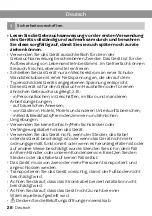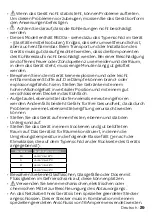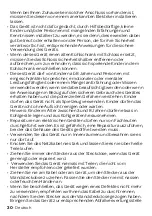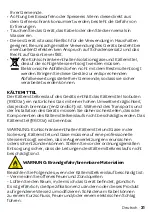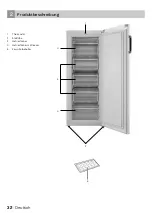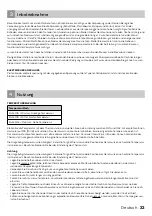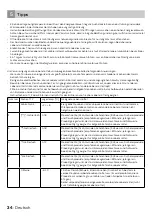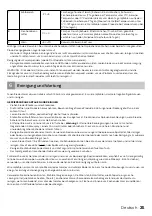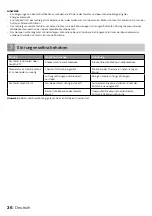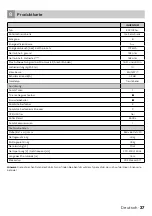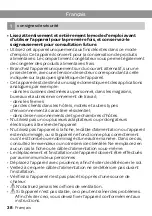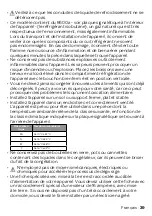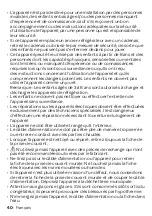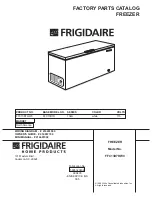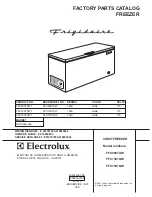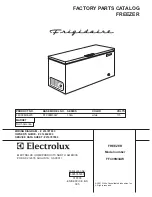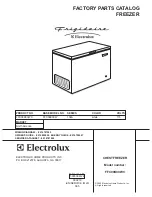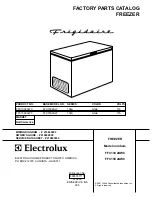
cleaning & maintenance
6
Defrost the freezer compartment when the layer of ice reaches a thickness of 3 to 5 mm. It is recommended to combine
defrosting the appliance with cleaning it.
• Unplug the appliance.
• Open the door and remove the food from the freezer. Keep the contents of the freezer in a cool place and wrapped in blankets
or newspapers.
• Leave the door open, this will speed up the defrost process.
• Place a container under the freezing compartment and wait for the ice to defrost. You can speed up the defrosting process by
placing a bowl of hot water in the freezer.
Remove the ice with a plastic ice scraper.
Warning:
Never remove the ice with the aid of sharp objects, defrost sprays, a hair-drier, a heater, or similar items. This may
lead to unsafe situations and may cause irreparable damage to the appliance.
• Clean the interior of the appliance. Use warm water and a neutral detergent to prevent any bad smells occurring. After cleaning,
rinse the interior with clean water and rub dry.
• Leave the appliance to dry for 1 to 2 hours. Simply remove the drawers to clean them by hand. Do not clean the interior
accessories in the dishwasher.
• Clean the outside of the appliance and the gasket with a soft moist cloth.
• Switch the thermostat on to the right setting. When the freezer compartment reaches its correct temperature, replace the
food items.
For areas that are difficult to clean in the appliance, such as narrow gaps or corners, it is recommended to wipe them regularly with
a soft rag, soft brush, etc. When necessary use some auxiliary tools, such as thin sticks (tooth picks), to ensure no contamination
can accumulate in these areas.
We recommend that you dust the back of the appliance and on the floor with a cloth or vacuum cleaner once a year in order to
maintain a good output and low energy consumption.
Do not use hard brushes, cleaning steel wire balls, wire brushes, abrasives, such as toothpastes, organic solvents (such as alcohol,
acetone, oils, etc.), boiling water, acid or alkaline items to clean the refrigerator considering that this may damage the fridge
surface and interior. Boiling water and benzene may deform or damage plastic parts.
NOTES
• Excessive accumulation of ice on the freezing areas impairs the appliance’s freezing capacity and increases the energy
consumption.
• Defrost the appliance at least once or twice a year. In case of a higher ice build-up, defrosting must be carried out more
frequently.
• After taking the food out of the freezer, put it in a container, wrap it with several layers of paper, a blanket and store it at a cool
place.
• The defrosting operation should last as short as possible. Long storage of food at the ambient temperature shortens their shelf
life.
Note: please store different foods according to the compartments or target storage temperature of your purchased products.
- If the refrigerating appliance is left empty for long periods, switch off, defrost, clean, dry, and leave the door open to prevent
mould developing within the appliance.
Water dispenser cleaning (special for water dispenser products):
- Clean water tanks if they have not been used for 48 h; flush the water system connected to a water supply if water has not been
drawn for 5 days.
WARNING -Food needs to be packed in bags before putting into the refrigerator, and liquids need to be packed in bottles or
capped containers to avoid the problem that the product design structure is not easy to clean.
English
•
25


















